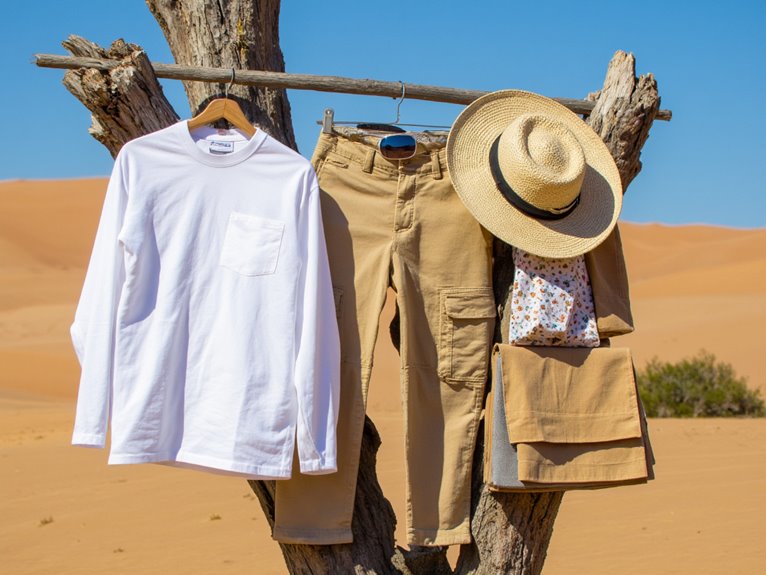Choosing Sun-Protective Shirts, Pants, and Accessories
You’ll need UPF 50+ rated clothing that blocks 98% of UV radiation for maximum protection. Choose tightly woven synthetic fabrics like polyester in dark colors such as navy or black, which absorb more UV rays than light shades. Guarantee generous fits that don’t stretch fabric thin during movement. Essential accessories include wide-brim hats with 3-inch brims and UV400 wraparound sunglasses. Test durability by holding fabric to bright light—increased light penetration indicates degraded protection. Understanding proper fabric construction and testing methods will help you build a thorough sun defense system.
We are supported by our audience. When you purchase through links on our site, we may earn an affiliate commission, at no extra cost for you. Learn more. Last update on 18th December 2025 / Images from Amazon Product Advertising API.
Notable Insights
- Choose garments with UPF 50+ ratings that block 98% of UV rays for excellent protection.
- Select tightly woven synthetic fabrics in dark colors like polyester for maximum UV blocking effectiveness.
- Ensure proper fit with loose, long-sleeved designs that maintain fabric integrity during movement and activity.
- Include essential accessories like wide-brim hats, UV400 sunglasses, and UV gloves for comprehensive coverage.
- Test fabric durability regularly by checking light penetration and using UV test cards after washing.
Understanding UPF Ratings and Certification Standards
Protection from ultraviolet radiation in clothing is measured through the Ultraviolet Protection Factor, or UPF rating system.
UPF significance lies in its thorough measurement of both UVA and UVB radiation blocking capabilities, unlike SPF which only measures UVB protection. A UPF 30 garment blocks 29 out of 30 UV units, allowing just 3% transmission to reach your skin.
UPF provides comprehensive UV protection by measuring both UVA and UVB radiation, blocking 97% of harmful rays with UPF 30 rating.
The certification processes require standardized spectrophotometer testing using artificial light sources and sunburn weighting curves. Labs test new fabrics under controlled conditions to validate protective performance. The AATCC Test Method 183 was established in 1998 to provide standardized testing protocols for sun protective fabrics.
UPF ratings fall into three categories: 15-24 (Good), 25-39 (Very Good), and 40-50+ (Excellent). The Skin Cancer Foundation requires minimum UPF 50 for its certification seal, ensuring maximum protection for consumers seeking verified sun-protective clothing. Higher UPF rating signifies better protection, with UPF 50+ providing the most effective coverage against harmful ultraviolet rays.
Fabric Types and Weave Density for Maximum UV Protection
When selecting sun-protective clothing, you’ll find that fabric construction plays a more critical role than brand names or price points in determining actual UV protection levels.
The weave density, fiber composition, and color depth work together to create an effective barrier against harmful radiation—with tightly woven synthetic fabrics in darker colors providing the highest protection ratings.
Understanding these three core factors will help you identify garments that offer genuine sun protection rather than just marketing claims.
Dense Weave Benefits
Although all fabrics provide some level of UV protection, dense weave construction creates the most effective physical barrier against harmful solar radiation. Dense weave fabrics minimize gaps between fibers, markedly reducing UV transmission through the material.
You can test fabric density by holding it against light – minimal light penetration indicates superior protection.
Different weave types offer varying protection levels:
- Satin weave delivers the lowest solar radiation transmittance, often below 5% UV transmission.
- Twill weave provides comparable protection to satin in high-density configurations.
- Plain weave typically offers less UV blocking than satin or twill at equivalent densities.
High-density fabrics prevent over 95% of UV radiation by blocking both direct transmission through pores and indirect transmission through yarn fibers. Dense weave creates an essential foundation for effective sun protection clothing.
Natural Vs Synthetic Fibers
Beyond weave density, the fundamental choice between natural and synthetic fibers profoundly impacts your garment’s UV protection performance.
Polyester leads synthetic options with tight weaves that absorb UV rays effectively, commonly achieving UPF 50+ ratings. Nylon provides moderate protection but requires chemical treatments for higher UPF values. However, synthetic fabric drawbacks include microplastic shedding, heat retention, and chemical UV blockers that degrade over time while potentially causing skin irritation.
Natural fiber benefits include inherent UV resistance without chemical treatments. Unbleached cotton contains lignins that naturally absorb UV radiation.
Specialized natural fabrics like SolarCotton achieve UPF ratings of 70-244 without synthetic additives. While natural fibers typically offer lower baseline protection than engineered synthetics, they avoid environmental pollution and chemical absorption risks associated with treated synthetic materials.
Color Impact on Protection
Which colors deliver the strongest UV defense in your sun-protective wardrobe?
Dark colors absorb and block more UV radiation than light shades, providing superior protection through enhanced solar energy absorption.
Color psychology suggests darker hues create psychological comfort, while the technical reality proves their UV-blocking superiority.
Dye effects considerably impact protection levels.
Colored fabrics contain benzene atoms in dye molecules that absorb UV rays, making even light-colored dyed fabrics more protective than undyed alternatives.
Key color protection principles include:
- Dark colors absorb maximum UV radiation for highest protection levels
- Bright colors effectively absorb UV light, rivaling dark color performance
- Dyed light colors outperform undyed fabrics due to benzene atom UV absorption
Understanding these color dynamics helps you select garments that maximize UV defense while maintaining your preferred aesthetic choices.
Proper Fit and Coverage Design Features
Achieving ideal UV protection requires careful attention to how your sun-protective clothing fits and covers your body. Slightly generous fits maintain fabric integrity while allowing proper airflow. Tight clothing stretches fibers, reducing UPF effectiveness and compromising protection.
Essential fit adjustments and coverage enhancements include:
- Long sleeves and pants that provide maximum skin coverage without restricting movement
- Adjustable elements like cuffs, collars, and hoods for personalized protection of vulnerable areas
- Loose-fitting designs that prevent fabric thinning while accommodating dynamic activities
Proper sizing requires accurate body measurements against brand-specific charts.
Synthetic fiber blends with elasticity guarantee fit retention during physical activities. Features like thumbholes, neck flaps, and side vents enhance both coverage and mobility.
Breathable, moisture-wicking fabrics regulate temperature while maintaining protective coverage throughout extended outdoor exposure. Like travel rain jackets, sun-protective clothing benefits from adjustable hoods and functional design elements that enhance both comfort and protection during outdoor activities.
Essential Accessories and Complete Sun Protection Systems
How effectively does your sun protection strategy shield every vulnerable area of your body?
Accessory importance becomes clear when you realize sunscreen alone can’t protect every exposed surface. A thorough systems approach combines multiple protective elements for maximum coverage.
Your complete protection system should include these essential components:
- Wide-brim hats with 3-inch brims that shield face, neck, and shoulders while offering UPF 50+ ratings
- UV400 sunglasses with wraparound designs providing 100% UVA/UVB protection for eyes and delicate surrounding skin
- Specialized accessories like SPF lip balm and UV gloves protecting frequently overlooked areas during outdoor activities
This layered strategy addresses gaps where individual protection methods fail.
UPF clothing covers your torso, while accessories protect extremities and facial features that clothing can’t reach.
Frequently Asked Questions
Can I Layer Regular Clothes to Achieve Higher UV Protection?
Yes, you can layer regular clothes for improved skin protection. Combining dense fabric types enhances UV blocking compared to single layers. However, proper layering techniques with multiple garments rarely match certified UPF clothing’s effectiveness.
On a final note
You’ve now got the technical knowledge to select effective sun-protective clothing. Choose garments with UPF 30+ ratings, tightly woven fabrics, and darker colors when possible. Ascertain proper fit with minimal skin exposure through extended sleeves and high necklines. Don’t forget essential accessories like wide-brimmed hats and UV-blocking sunglasses. Regular durability testing and proper care will maintain your clothing’s protective properties throughout its lifespan.

